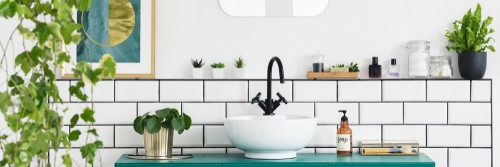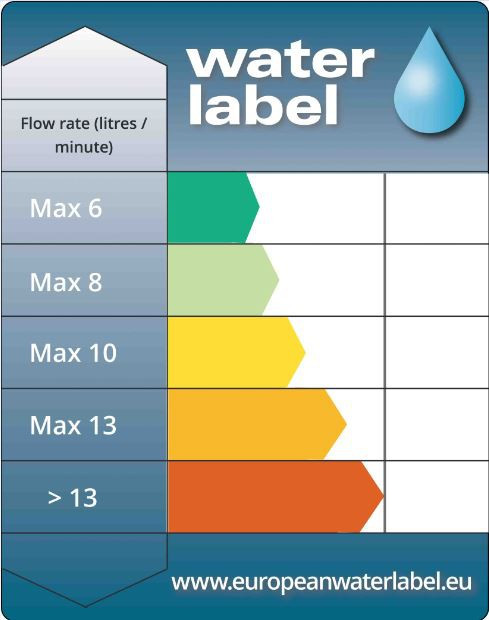Saving Water
Did you know that much of your water use at home contributes to your energy bill?
Each household in the UK uses on average around 330 litres. About 15% of a typical gas heated household's heating bill is from heating the water for showers, baths & hot water from the tap. This on average is around £80 per year.
Saving water can reduce your water bill (if you're on a water meter), reduce your energy use & bills, reduce the impact on your local environment, & reduce carbon dioxide emissions by using less energy to pump, heat & treat the water.
When we use water, we are often using energy, mostly to heat the water. Generating energy produces carbon dioxide emissions which is one of the main greenhouse gas causing climate change. Heating water for use in our homes makes up about 4% of the UK's total carbon dioxide emissions.
Water Heated By A Boiler
In most homes, the hot water is supplied by the main central heating boiler, either directly if it is a combi boiler, or from a hot water cylinder. Often there will be an electric immersion heater in the cylinder as well.
A tip - use the boiler to heat the water, even in the summer. The immersion heater will be more expensive & should only be used as an emergency back-up.
Water Heated By Immersion
In some properties, particularly those with electric storage heater, water can only be heated by the immersion heater. There may be 2 immersions, one in the top of the cylinder & one in the bottom. Usually the bottom heater comes on at night, & heats the whole cylinder using cheaper, off-peak electricity. The top heater is used to provide additional hot water during the day, using the more expensive, peak-rate electricity.
Five steps to saving money on your hot water bills
- Use less water (hot water in particular)
- Insulate your hot water cylinder - a well fitted tank jacket could save you around £20 per year, more if you heat your water electrically. Insulating the hot water pipes will save you more energy, & can help your taps to run hot more quickly
- Controls - make sure you have the right controls, & have them set correctly to give you enough hot water when you want it, & not when you do not
- Fuel switching - gas is cheaper than electricity or oil, so consider switching if you can
- Solar - once fitted, solar water heating can provide a good proportion of your hot water requirements with virtually no running costs.
Passive Flue Gas Heat Recovery Device
If you have a combi boiler, you may not be able to fit solar water heating, but you may be able to fit a Passive Flue Gas Heat Recovery Device (PFGHRD). This recovers additional heat from the boiler's flue gases & uses it specifically to heat the hot water.
Products - Water Saving
Water-Efficient Showerheads - New water-efficient showerheads use technology that can produce water flows that feel far higher than they actually are - an easy way to save both water & energy. They are most effective on power & mixer showers with a high flow rate. You should not attach a low flow showerhead to an electric shower as this could cause possible damage to your shower unit.
Reduced-Capacity Baths - A standard bath has a capacity of around 80 litres, so even when it's less than half full, it uses a lot of water. If you are buying a new bath, look for one with a lower capacity. Of course, you can always save money & water by taking a quick shower instead of a bath.
Water-Efficient Appliances - Looking to replace water-using appliances such as dishwashers or washing machines? Look for products with the new Water Efficient Product Label and/or the Waterwise Recommended Check-mark as these models can help to save water, energy & money.
Lower Flow Taps - Taps with a low flow can be fitted to bathroom & kitchen sinks. Clock point taps are better for kitchen sinks taps, aerated or regulated flow taps are more suitable for a bathroom sink; but all work very well.
Water-Efficiency Labelling - To help you identify water-efficient products, look for the European Water Label (pictured below) that is an easy way to recognise bathroom products which, when installed & used correctly, will use less water, save energy & save money. award-winning water-efficient products, may also carry the Waterwise Recommended Check-mark.
Water-Saving Habits - No-one likes to waste water. However, many of us don't realise that water usage contributes to energy bills. Simple water use changes can save you money.
Bath - If everybody in your family of 4 replaces one bath a week with a 5 minute shower, up to £20 a year could be saved on gas bills & up to £25 on water bills (if you have a water meter).
Change your head - If a family of 4 replace their inefficient shower head with a water-efficient one, they could save around £75 off their gas bills & around £120 off their water bills (if they have a water meter) each year. That's a total of £195 saving!
Turn it off - A running tap wastes more than 6 litres of water per minute, so turn off the tap when brushing your teeth, shaving, or washing your face. Use cold water if you do not need hot. A dripping tap can waste more than 5,500 litres of water each year, so make sure your taps are turned off properly & change your washers promptly when taps start to drip.
Make it go further - Try to avoid wasting water from running taps while waiting for hot water.
Fill them up - Make sure that dishwashers & washing machines are full before you use them, & always use the most efficient water & energy settings.
Using a washing up bowl to wash up plates or cutlery twice a day rather than having a hot tap running could save arounf £25 per year on your gas bill & about £30 on your water bill (if have a water meter). If you need to rinse utensils or wash vegetables, use col water if possible & do not leave the tap running.

